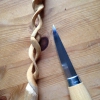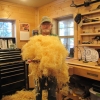I have to make a choice of wood for this carving. Which to select?
Choosing the best wood for the job in hand seems to be a mixture of knowledge and imagination. In this lesson you can listen in to my thought processes as I look at each flitch of timber, different woods that might suit the carving, and how I make the decision. At the end of the day it sometimes comes down to an 'educated guess'...

| 09 February 2021 19:27
Thomas - Birch is used a lot in Finland, for example, though in the UK we don't get much in the way of boards. Sycamore I use on the site here.
I wouldn't use old railway sleepers. In the UK they were mostly pitch pine, never oak, and my experience is that they are full of splits/shakes and dirt. But European oak is good; again we use it here.
It's definitely a good idea to try different woods and see what you feel about them; we all have our preferences.
BTW - if you can, always go for air-dried wood. Kiln drying tends to make the stuff harder and more brittle.

| 09 February 2021 14:26
Yes that definitely helps chris thanks
I’ve had my eyes opened a little to alternatives
Birch is one been suggested and I’m sure I can lay my hands on some
Sycamore has also been suggested
Any others you can recommend?
Also I know of a pile of old railway sleepers i assume they’re oak and could probably get them for very little price wise I would then mill them myself
Have you ever tried that ?
Would be a lot of work but would end up with quite a lot carving material

| 09 February 2021 14:03
Thomas - Yes, you cannot get far without wood! I guess you think it grows on trees but, from our point of view as carvers, we have to find sources where the wood has been converted into boards and seasoned (dried).
I don't know where you live but it wouldn't matter too much; we have subscribers from around the world with the same problem: where do I get suitable wood?
Do see this as a challenge, rather than a problem. There is wood out there; you just need to find it.
Here are some ideas:
1. Online searching - can be very fruitful. They want to sell you their wood!
2. Fish where the fish swim. In other words, also search for woodcarvers, turners etc; carving and turning suppliers
3. Try also woodcarving clubs, magazines - that sort of thing. People who use the wood. Perhaps start a club and pool resources
Lastly:
You may have to buy more than you want at the moment. And you should if you are interested in pursuing carving into the future. Snap it up where you find it and build up a reserve. You can't get far without it and it's good to have wood to fire off ideas...
So, a bit of work on your side if there's nothing immediately to hand, but that's the nature of the beast I'm afraid. Sorry there is no easy answer.
Hope this helps.

| 08 February 2021 15:12
I have my subscription
I have some chisels
I have a space and bench to work on
I don’t have any lime wood and finding it very difficult to get any
where can I find some? it’s all i need to get going been weeks now

| 22 May 2020 07:50
Cody - Congratulations on finishing your first carving! I hope there will be many more to come.
I'm surprised at what you say about the Basswood; my experience has been that the grain is fairly innocuous. Figuring does become more pronounced with oiling; did you finish it with anything?
Grain, figuring, is an issue with the sort of carving I do. We only deal with light and shadow so we need bland woods - such as Basswood - that won't camouflage the effect. Figuring works best on wide open space such as bowls and shaped sculpture. But picking our wood can be a bit hit or miss sometimes, as you have found; no matter what the surface looks like there can be unusual or unwanted figuring below. We are working fully 3 dimensionally after all, not just picking surface appearance as a furniture maker might. I've definitely had to abandon commissions because the wood has 'let me down' in this way. But that's the joy of wood!
Don't let it put you off. I never work from a rough surface and I recommend you plane it clean so you can at least see what you are starting with. And carve the feather again - you'll be much quicker a second time! - but working from the other side of the board; see if that makes a difference.

| 21 May 2020 23:00
Chris,
I just finished my first carving (the low relief feather from the beginners section). I'm generally pleased with the result but I do wish the grain was less pronounced. I purchased the board (4/4 basswood) rough sawn and so I couldn't see the grain until I planed up a face. In your experience is getting the plain grain I was hoping for a matter of luck, or can I set myself up better in the future? Maybe a quarter sawn face might be better?
Best,
Cody

| 08 April 2018 16:07
Larry - Carving end grain crops up in all sorts of projects on the site, the main one I can think of is the Owl project - the last stages (feet), which will publish 20th April.
I think the best thing is for you to get a bit of spare wood and just experiment on the end grain: it's not so much the handling of the carving tools as the way you don't have 'normal' shavings. and it's harder work. Every time you dive into a piece of wood you cut across the ends of the fibres, but the real difference is what you are working at 90 degrees to the tree.
End grain also soaks up oils and stains differently from the side grain, but that always happens in a carving of course.

| 08 April 2018 02:27
Chris -- Are there any carving projects that lend themselves to using end grain rather than one face or another of flat-sawn wood? End grain carves and finishes so much differently (with somewhat more difficulty, too); seems like there might be different techniques or types of carving that would fit best with it?
Thanks so much,
-- Larry Day

| 09 May 2016 07:43
Liam - I know of carvers who test the sharpness of their tools by cutting the hairs on their forearm - equally odd thing to do! I test my tools in wood I'll be carving and that's what I'd suggest you do. Mostly for me that will be lime or oak and I have a piece near the sharpening bench for testing.
Pine: that's a word that really doesn't mean a lot and people often suggest it because it's readily available Much depends on how it's grow as well as the species and most is hardly suitable for carving. Slow grown pine from Northern Russia, say, is tight grained and carves beautifully; pine from fast grown sources, for the building industry, is horrible to carve. The fibres of soft woods like these give way, roll or crumble in front of the cutting edge, so aren't cut cleanly - thus you need a longer more delicate bevel for these soft woods, a profile which is not much good for the 'normal' density of carving woods, ones that resist enough to be cut.
The sorts of wood I like to work in, leaving the wood from the tool - lime and oak for example - have a porous grain and 'let go' of the cutting edge. Some woods aren't porous, are heavier because full of oils etc and these are a hard to carve my-style with the cutting edge sticking. However, they polish really well and look wonderful in more sculptural forms.

| 08 May 2016 23:37
Hello Mr. Pye,
I have a question regarding wood species and how well certain ones cut. I know that you obviously haven't carved every single kind of wood, but I'm hoping you can help me with my question. I just came across an extremely talented carver; on her website, she had a few tips for woodcarvers. One of them was that you should periodically test your carving tools for sharpness by cutting across the grain in a spare piece of pine. That was very confusing to me, because when I have tried cutting pine before (as well as cedar), I have found that no matter how sharp I my tools are, they always tear the pine when I cut across the grain. Now I know that it is not because my tools are not sharp, because they cut just fine in all the other woods I've tried carving - with the exception of pine and cedar. So my questions specifically are: 1) do you know why this only happens in pine and similar woods, and 2) if this is a common characteristic of pine, why would such an experienced carver suggest it?
I apologize for the length of my question!
Thank you,
Liam Hedrick

| 17 September 2015 17:39
Bruce,
It seems you've been carving a while so probably have figured this out already but for those yet to learn laminating the hard way, it is worth gold to spend a whole lot of time matching the direction of the grain of the pieces being joined. It needs to be done in both planes, for example, if gluing two flat planks edge to edge, you need to match direction in the glued surfaces as well in the flat surfaces across the joint. Seems an obvious thing to look out for but it's not as easy to get right as it might seem. If you have nice wood and only one joint, it's not too bad, but for awkward wood with more than one joint you can end up juggling the pieces forever.

| 16 July 2015 06:43
Bruce - Ideally, you'd have a single piece of beautiful, stable wood, wood that's not going to split. Reality? Hard to come by about 7in. So, yes, I do end up gluing wood. There's a difference between joining up a panel and joining a block. The nub of what you need to know is here: Videos > Carving Matters > Wood Selection > Warping. The main things I look for are a sympathy in the way the ring patterns fall, and the figure or colour matching - trying to balance the two. Often it takes a while to come up with the best arrangement and I end up with a compromise. With flat, seasoned boards, good wood glue and proper clamping, it's rare that I have joints opening even when there's a bit of antagonism in what might be movement in the boards. Have fun!

| 15 July 2015 18:37
Thank you for this excellent resource Chris. I have enjoyed tying a lot of loose ends together. Today I am wondering about some larger in the round projects I have in mind which require material 7-12 inches thick. Do you laminate smaller pieces to achieve this dimension? What issues to keep in mind if you are doing this?

| 13 April 2015 11:08
Duncan - You are essentially right. I cannot fully answer your quateion here but there's a lot of info in my book Woodcarving Tools, Materials and Equipment' volume 2. Also I guess the Internet will have an abundance of info too.

| 01 April 2015 17:57
I'm slowly gathering a selection of carving wood for future projects. Have you any guidance on how to store wood?
I guess too dry an environment with split wood. My guess would be cool conditions with air flow to keep down mildew? Duncan

| 14 January 2015 15:03
Raul - That's ingenious. One of the things I like about woodcarving is having to find new ways of doing things. Far better exercise for the mind than sudoku!

| 14 January 2015 06:48
Hi Chris, I have a solution to test, I'll make a rectangular mold with sawdust or newspaper and white wood glue. Finally I can have a flat surface to draw on the branch of the tree.
What do you think of my idea?

| 13 January 2015 07:21
Hi Chris, I have a problem to copy the drawing in a wood. It's a tree branch cut from my garden .This is a small cylinder and is not flat. For me it is difficult to copy the drawing.
How I can copy the drawing in a small cylinder tree branch ?

| 05 June 2014 15:29
Charlie - There are about 30 species of 'Tilia', what we in the UK call Limewood and Germans call 'Linden' (and we did once as well - as in Vaughan Williams' 'Linden Lee'). Basswood is Tilia Americana - a similar tree but differing in the timber as I describe above. In the UK, I cannot obtain Basswood; and in the USA it's very difficult to get Limewood.

| 05 June 2014 08:58
I had always been under the impression that basswood was the American name for lime. You live and learn.

| 13 April 2014 20:00
David - That's a lot of questions! You'll need to do your research off site; I can't do justice to all you want to know in what is really a video-comment box. But to answer briefly, in order: No. they are different, Basswood is more like Birch to me. Yes, I've carved both and much prefer Limewood. Yes, all kiln dried timber is more brittle than air dried as you say, so best to carve air dried if you can get it. No, I've never carved Northern Pine. I'm in the UK - you'll need to research suppliers where you are writing from. And, yes, we can get carving woods readily in England. I get my Oak from both suppliers and tree fellers. Buy more than you need and build up a stock. Hope this helps.

| 12 April 2014 18:29
Chris, is Limewood identical to basswood? Have you carved both? Is there any difference between air dried basswood and kiln dried? Usually kiln dried wood is more brittle, harder to carve because the lignin is hardened by the kiln drying process.
Some professional carvers, doing detailed picture frames, use "Northern Pine". I think this is canadian hemlock, but I am not sure. Have you ever carved this "Northern Pine"? Do you know of a supplier?
Are there lumber suppliers in England that cater to wood carvers? Do you get your air dried english oak from a supplier or from the landscapers who are cutting down trees?
Great video, I have so much more to learn about the wood.
David

| 29 March 2013 20:44
Ann - If you have good working drawings, perhaps developed from a model, then you should be able to start near your final surfaces, especially if you can bandsaw, and not have to remove too much more than you need to. But, at the end of the day, having too much wood is better than not enough!

| 29 March 2013 10:20
I'm beginning to "see", as a relative beginner, that I need in-the-round much more wood than it seems at the start... any reflections on this?

| 13 February 2013 09:51
Ann - It's a good question. The answer is yes, but rarely. I almost always have the idea first and then execute it in the wood. Having said that, I often adapt my idea to the wood I have. It's like having enough wood around so I have choices; so I can say, 'This is what I want to do and, oh yes, if I do it like so, that's the piece of wood it will work in'. There's no right or 'wrong' here, or 'normal' or not. It does seem that carvers more into sculptural form go for 'making the wood speak'. I suppose I more ask the wood to join the dance...

| 09 February 2013 21:17
Maybe a silly point, Chris, but have you ever worked a different way around: looking at a piece of wood and asking yourself and it what it could or wants to be? Maybe as an amateur and with fewer pieces of wood to choose from, I do find myself doing that as often as the "normal" way around.

| 21 January 2013 14:21
Eric - Great suggestion. I'll do my best!

| 20 January 2013 17:12
Chris, may I suggest that you do this with EVERY project you video as a project. It is priceless and seems to me to be one of the key steps in every project. Maybe just take two minutes to say why you selected the particular piece of wood you did for the project each time. This way we to be "inside your head" like the movie Being John Malkowich!